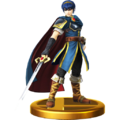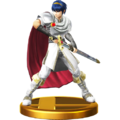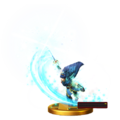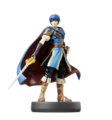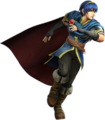Marth (SSB4)
| Marth in Super Smash Bros. 4 | |
|---|---|
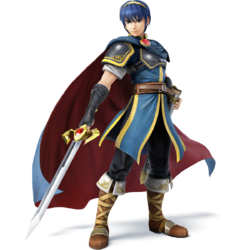 
| |
| Universe | Fire Emblem |
| Other playable appearances | in Melee in Brawl |
| Availability | Starter |
| Final Smash | Critical Hit |
| Tier | G (41) |
Marth (マルス, Marth) is a playable character in Super Smash Bros. 4. He was announced on the official website on November 7th, 2013; years before, four Fire Emblem games were released within a similar timeframe; Fire Emblem on November 3rd, 2002 in North America, The Sacred Stones and Path of Radiance on November 4th, 2005 in Europe, and Radiant Dawn on November 11th, 2007 in North America. He was among the first wave of amiibo figures that are compatible with SSB4 and is voiced once again by Hikaru Midorikawa in the international release, albeit using recycled voice clips from Brawl.
Marth currently ranks 41st on the SSB4 tier list, in the upper G tier, an extreme fall from his 5th place position out of 38 in Brawl. Marth's upsides include good overall mobility and disjointed range on many attacks. All of his sword-based attacks in particular are quite rewarding if they land only at the tip of his sword, often dealing absurdly high knockback despite their quick startup, most notably his forward smash and Shield Breaker. However, the drop on Marth's tier placement is largely due to his initial transition into the game and receiving a myriad of nerfs in the process. The transition had hindered his reach relative to the cast (though he still overall has one of the better reaches in the game) and slightly increased the ending lag on many attacks, making his moveset less safe as a whole. His forward aerial, a staple move in his approaching and combo games, is laggier and less versatile than before. His throws are now ineffective for comboing past extremely low percents, while still unreliable for KOing, worsening his punish game. Marth's linear recovery is still susceptible to edgeguarding even with the new ledge mechanics, and he is vulnerable to combos, juggling, and projectile camping due to his lack of safe methods to relieve pressure. With such heavy nerfs and exiguous and insufficient buffs for compensation, Marth currently holds the distinction of having undergone the single largest drop in the tier list between Brawl and Smash 4. While he has a notable playerbase, his tournament results are poor and, in an almost identical manner to Falco, Marth's most recent iteration is heavily overshadowed by his high-tier placements in Melee and Brawl. However, his current position remains incredibly debatable, as later in patch 1.1.4 Marth would receive buffs in range, interruptibility and damage for many of his attacks, while the current tier list placements reflect the 1.1.3 metagame. Since the buffs in said update, Marth has achieved some notable results in lower-level tournaments and has also achieved significantly better (though still average overall) results in bigger tournaments, having placed 5th at KTAR XVII and 17th at Pound 2016, while before the patch such results were almost unspoken of for Marth. As such, his tier placement remains a question of significant debate among many players.
Attributes
Marth is emblematic of sword characters, making extensive use of disjointed hitboxes and his unique tipper mechanic. His attributes remain present; he has good overall mobility, sporting the fastest walking speed in the game (tied with Lucina), an above average dashing speed, average air speed, above average air acceleration, moderate falling speed, and low gravity, along with average weight.
Marth's playstyle remains fundamentally intact, being characterized by the properties of his sword, the Falchion. His attacks deal more damage and knockback if struck with the tip of the sword, encouraging and rewarding proper spacing. This is more clearly evident in moves such as his forward smash: when tippered, it is the third strongest forward smash in the game, while it cannot KO until well beyond 100% if landed untippered. Being a sword-wielder, Marth has the universal benefit of disjointed hitboxes. Many of his moves have good reach, fast startup, and cover wide arcs, such as his up tilt and forward aerial. As such, Marth aims to fight a step away from danger, where he can pressure and poke at the opponent without leaving himself open to punishment.
Marth's special moveset has good utility. His neutral special, Shield Breaker, as implied by its name, deals high shield damage even when uncharged, and is useful for punishing rolls. Side special Dancing Blade is a four-hit combo that can be used to punish sidesteps, and is an effective damage racker, dealing 15-20% if all hits connect. Marth possesses a Counter as his down special, giving him the capability to shrug off enemy attacks and return them with 1.2x the knockback, and is able to KO if a strong enough attack is countered, making it a good option against overly aggressive foes. Counter can also be used against opponents with easily predictable recoveries, such as Ness and Lucas. But his up special is arguably his most potent: Dolphin Slash has quick startup, and provides intangibility frames during its startup frames, and is relatively strong when it first comes out. These attributes make it an excellent out of shield option and combo-breaker. It is also Marth's primary method of vertical recovery, as it grants a high amount of vertical height along with a bit of horizontal distance, and its speed can make it difficult to intercept, while it can stage spike reckless edgeguarders.
Marth's disjointed range gives him an innately strong edgeguarding capability. His forward and back aerials have fast startup and good range, and are strong when tippered. Down aerial is relatively quick, and if it hits at the center of the arc (directly below Marth), it powerfully meteor smashes opponents. Forward smash's range makes it a good choice against opponents aiming their recoveries towards the ledge. Also, Marth's low gravity and only average falling speed allow him to maneuver effectively offstage.
However, Marth also exhibits glaring flaws, largely as a result of his initial transition into Smash 4 and the myriad of nerfs he has received in the process. As a result of his heavier reliance on tippers and spacing ability, he has a poor up-close game, giving him a hard time against rush-down characters, notably Captain Falcon. Though his attacks have quick startup, many of them have high ending lag, with his aforementioned forward smash being a notable case. His attacks also suffer from short hitbox durations. For example, his forward aerial, despite covering a wide arc in front of him, has a hitbox that lasts for only 3 frames, and comparatively high ending lag and noticeable landing lag, and along with its very strict autocancel window, it is a surprisingly poor approach option. This combination of high ending lag on his moves and his requirement for careful spacing result in a lackluster neutral game, as none of his approach tools are particularly reliable or consistent, and this is exacerbated by his lack of a projectile.
Not only does Marth struggle to win in neutral, but his conversions are unreliable and weak. Aside from having a fairly fast pummel , his grab game is poor. His throws deal low damage and have high base knockback, making them poor for combos and damage-racking. Except for up throw, they have low knockback growth, preventing them from KOing at realistic percents, while up throw can KO only starting at 160%. As such, Marth has poor options against shields, and Shield Breaker is highly punishable if predicted. Marth's weak throws tie into his inconsistent KO power. Furthermore, his tipper mechanic actually puts him at a disadvantage here, for his normal attacks are weak and do not generate much knockback if not spaced properly. Lastly, his edgeguarding ability, though strong, is flawed, both due to the need for tippers and the high ending lag on his aerials, with his down aerial suffering from roughly 45 frames of ending lag.
Marth himself is vulnerable to edgeguarding. Dolphin Slash is his only reliable vertical recovery option, but its path is linear and its distance is fixed, making his recovery very predictable and easy to intercept. Additionally since this move grants little horizontal distance, Marth is vulnerable to semi-spikes. Shield Breaker can aid his horizontal recovery, but it still covers little distance and has to be charged in order to be a reliable recovery tool. As a result, Marth will be in considerable peril if he is forced offstage without his double jump, since he is heavily reliant on it to mix up the timing of his up special recovery. Despite having only average weight and falling speed, Marth is susceptible to combos, and his tall hurtbox makes him easy to hit. Dolphin Slash is his only reliable combo-breaker, but as it leaves him helpless, it can inadvertently put him in an even worse position. While Counter can be used against overly aggressive foes, a cautious opponent will find ways to bait it and punish accordingly. He also has little defense against juggling. His aerials' high ending and landing lag make them ineffective at relieving pressure, and are sometimes unsafe to hit if not tippered.
With customs turned on, Marth gains some options to address some of his drawbacks, at the cost of creating different ones by doing so. Dashing Assault lets him punish landings and rolls, create trap situations, and force opponents off stage, but loses its tremendous power and shield breaking capabilities. Crescent Slash gives Marth more horizontal recovery, but with much less vertical recovery. It also grants him a fairly reliable follow-up from his forward throw and aerials at low percents and can punish airdodge landings, but it cannot be used as an out of shield option. Dolphin Jump gives Marth more vertical distance and greater horizontal control, but loses all of its offensive use. Iai Counter has quicker startup (counters from frame 3), increased range and power, and deals electric damage as well, but has much stricter timing.
Overall, while Marth does have notable advantages in his tipper mechanic, reach, mobility, and the fast startup of his moves, his flaws overall outweigh his strengths, giving him a weak neutral game and making his punishes unreliable due to their inconsistency. And his playstyle is so overly centered on his tipper mechanic that it arguably hinders him as much as it helps. As a result of his issues, he has only average tournament representation and average results, though still unremarkable overall.
Changes from Brawl
Possibly as a result of his dominance in previous appearances, Marth has been noticeably nerfed overall in his transition from Brawl to SSB4. While Marth's disjoint has been slightly increased, he has less reach relative to the cast as a result of many characters getting the same treatment, negating his key advantage from past games. As a result, this makes it much harder for him to control space. His air game, another strength in previous iterations, has been significantly nerfed. His forward and down aerials have increased startup; the former has a shorter hitbox duration, higher ending and landing lag, and autocancels much later, effectively removing his main approach option from Brawl, while the latter has a much smaller meteor smash sweetspot, hurting its edgeguarding utility. Down tilt has higher ending lag, rendering it less effective as a defensive option.
Marth's damage racking game has also been nerfed. The base knockback on his throws has been significantly increased, making them ineffective for combos past extremely low percents, and removes his ability to tech-chase. However, their knockback growth is still low, and so, aside from up throw, they cannot KO realistically. This is further compounded by the removal of chain grabbing, as the low damage output of his throws is more pronounced. His aerials are less effective for comboing and juggling due to their increased lag. Despite these nerfs, he has not been compensated in the damage output of his individual moves, as all of his smash attacks and aerials deal less damage.
Marth's moves are generally stronger when tippered, and while this is technically a buff, it is overall detrimental given he now has less range relative to the cast. As a result of the weakened power of his non-tippered attacks and increased ending lag, many of his moves are unsafe on hit at lower percents untippered, and along with the loss of his tech-chasing ability, these changes make his KO power inconsistent.
Marth has received buffs in other areas, however. Shield Breaker has improved utility due to the weaker shields and higher shield-stun, and Counter reflects attacks with significantly increased knockback. His forward smash, when tippered, is considerably stronger, now being the third strongest of its kind. As Dolphin Slash was relatively susceptible to edge-hogging, it greatly benefits from the new ledge mechanics, improving Marth's recovery. His ground game has also been buffed, with his jab, tilts, and down smash having decreased ending lag allowing for new combo and kill set ups. Many of his tipper hitboxes have grown larger as well, improving his spacing game. These changes give him a better grounded spacing and combo game at the cost of having to more properly space and time his aerials. As a result, Marth is one of the very few characters to have been truly nerfed in the transition to Smash 4, along with Meta Knight, Falco and King Dedede (though the former is still considered a dominant character unlike Marth). Though he has a dedicated playerbase in competitive play, his poor tournament results pale in comparison to his success in previous games, though as of 1.1.4, Marth has gotten much better and consistent results on a semi-regular basis.
Aesthetics
 Marth's design takes elements from his attire seen in Fire Emblem: New Mystery of the Emblem, Heroes of Light and Shadow[1] and Fire Emblem: Shadow Dragon, as opposed to his design from Fire Emblem: Mystery of the Emblem, which was used in Melee and Brawl. His eyes are also smaller and less anime-esque.
Marth's design takes elements from his attire seen in Fire Emblem: New Mystery of the Emblem, Heroes of Light and Shadow[1] and Fire Emblem: Shadow Dragon, as opposed to his design from Fire Emblem: Mystery of the Emblem, which was used in Melee and Brawl. His eyes are also smaller and less anime-esque. Marth's sword trails are much brighter at the tip; this makes the sweetspot of his attacks more visible than in previous games.
Marth's sword trails are much brighter at the tip; this makes the sweetspot of his attacks more visible than in previous games. Marth's sound effects for his sword slashes are less pronounced than in Brawl, overall being quieter. His Dolphin Slash in particular now produces a soft, short slashing sound, compared to the loud and prolonged noise it produced in Brawl.
Marth's sound effects for his sword slashes are less pronounced than in Brawl, overall being quieter. His Dolphin Slash in particular now produces a soft, short slashing sound, compared to the loud and prolonged noise it produced in Brawl.
Attributes
 Marth is slightly heavier than in Brawl (87 → 90), improving his endurance but making him easier to combo at early percentages from the changes to hitstun cancelling.
Marth is slightly heavier than in Brawl (87 → 90), improving his endurance but making him easier to combo at early percentages from the changes to hitstun cancelling. Almost all of Marth's attacks have slightly increased range compared to Brawl (apart from forward smash and Shield Breaker), ranging from a 0.25 increase to a 3.5 increase (2.5 before 1.1.4, as certain moves were increased further in said patch).
Almost all of Marth's attacks have slightly increased range compared to Brawl (apart from forward smash and Shield Breaker), ranging from a 0.25 increase to a 3.5 increase (2.5 before 1.1.4, as certain moves were increased further in said patch). Marth dashes faster (1.7 → 1.785).
Marth dashes faster (1.7 → 1.785). Marth's air speed is slower (1.034 → 1.02).
Marth's air speed is slower (1.034 → 1.02). Marth falls faster (1.5 → 1.58).
Marth falls faster (1.5 → 1.58).
Ground attacks
 Neutral attack has more range, transitions faster, and the second hit deals more knockback. The first hit also sends opponents at a higher trajectory (Sakurai angle → 78°/65°/90°) and has less ending lag (FAF 29 → FAF 25), allowing for follow-ups and mix-ups.
Neutral attack has more range, transitions faster, and the second hit deals more knockback. The first hit also sends opponents at a higher trajectory (Sakurai angle → 78°/65°/90°) and has less ending lag (FAF 29 → FAF 25), allowing for follow-ups and mix-ups. Neutral attack now comes out one frame later on both hits (4/2 → 5/3).
Neutral attack now comes out one frame later on both hits (4/2 → 5/3). Forward tilt is stronger (40 base/80 growth → 55 base/85 growth), and has slightly more vertical range. It also has noticeably less endlag (FAF 40 → FAF 34).
Forward tilt is stronger (40 base/80 growth → 55 base/85 growth), and has slightly more vertical range. It also has noticeably less endlag (FAF 40 → FAF 34). Forward tilt hits one frame later (frame 7-10 → 8-11).
Forward tilt hits one frame later (frame 7-10 → 8-11). Up tilt (8%/9%/12% → 5%/6%/9%), down tilt base (8%/9% → 7%), forward smash (14%/19% → 13%/18%) and up smash sourspots (4%/14% → 3/13%) all deal less damage, though with their knockback compensated.
Up tilt (8%/9%/12% → 5%/6%/9%), down tilt base (8%/9% → 7%), forward smash (14%/19% → 13%/18%) and up smash sourspots (4%/14% → 3/13%) all deal less damage, though with their knockback compensated. Up tilt deals overall more knockback (40/30 base/120/118/116/90 growth → 65/52 base/100 growth) and has decreased ending lag (FAF 40 → FAF 34). Additionally, all of its hitboxes now produce vertical knockback (110º/Sakurai angle/85º → 100º/85º).
Up tilt deals overall more knockback (40/30 base/120/118/116/90 growth → 65/52 base/100 growth) and has decreased ending lag (FAF 40 → FAF 34). Additionally, all of its hitboxes now produce vertical knockback (110º/Sakurai angle/85º → 100º/85º). Down tilt deals more base knockback (50/40/25/20 → 50/40) and has slightly increased max range.
Down tilt deals more base knockback (50/40/25/20 → 50/40) and has slightly increased max range. Down tilt has increased ending lag (FAF 22 → FAF 24), and only lasts 2 frames instead of 3. It also no longer moves Marth forward, removing its ability to pseudo-crawl.
Down tilt has increased ending lag (FAF 22 → FAF 24), and only lasts 2 frames instead of 3. It also no longer moves Marth forward, removing its ability to pseudo-crawl. Tippered forward smash has more knockback growth (70 → 80), now being the third strongest in the game. The tipper hitbox is also slightly larger (3 units → 3.5 units).
Tippered forward smash has more knockback growth (70 → 80), now being the third strongest in the game. The tipper hitbox is also slightly larger (3 units → 3.5 units). Sourspotted forward smash deals less base knockback, but more knockback growth (60 base/70 growth → 55 base/80 growth). This makes it less effective at lower percents, but the increased growth means it still KO's at the same percent as in Brawl, and is even more effective as the percent's rise higher due to the higher growth.
Sourspotted forward smash deals less base knockback, but more knockback growth (60 base/70 growth → 55 base/80 growth). This makes it less effective at lower percents, but the increased growth means it still KO's at the same percent as in Brawl, and is even more effective as the percent's rise higher due to the higher growth. Forward smash has noticeably less reach (10.5 units → 9.05 units) and increased ending lag (IASA frame 49 → frame 51).
Forward smash has noticeably less reach (10.5 units → 9.05 units) and increased ending lag (IASA frame 49 → frame 51). Up smash has a slightly larger hitbox radius overall. Tippered up smash also has much more knockback growth (70 → 95).
Up smash has a slightly larger hitbox radius overall. Tippered up smash also has much more knockback growth (70 → 95). Up smash has slower startup (frame 12 → frame 13), shorter hitbox duration (6 frames → 5 frames), and increased ending lag (IASA frame 49 → frame 58).
Up smash has slower startup (frame 12 → frame 13), shorter hitbox duration (6 frames → 5 frames), and increased ending lag (IASA frame 49 → frame 58). Down smash has less ending lag (FAF 64 → FAF 54).
Down smash has less ending lag (FAF 64 → FAF 54). Back hit of sweetspotted down smash has more knockback growth (80 → 88) and deals slightly more damage (16% → 17%).
Back hit of sweetspotted down smash has more knockback growth (80 → 88) and deals slightly more damage (16% → 17%). Back hit of down smash deals 1% less damage (13% → 12%) and the front hit deals much less damage (14%/17% → 8%/12%), making it weaker despite its increased growth on both the sweet and sour spots (70/80 → 88). Hitbox duration of both hits is shorter (3 frames → 2 frames).
Back hit of down smash deals 1% less damage (13% → 12%) and the front hit deals much less damage (14%/17% → 8%/12%), making it weaker despite its increased growth on both the sweet and sour spots (70/80 → 88). Hitbox duration of both hits is shorter (3 frames → 2 frames).
Aerial attacks
 Neutral aerial (6% (first hit, tippered), 9%/12% (second hit) → 5% (first hit, tippered), 7%/9.5% (second hit)), forward aerial (10%/13% → 8%/11.5%), back aerial (11%/14% → 9%/12.5%), and up aerial sourspot (10% → 9.5%) all deal less damage than in Brawl without much compensation on their knockback.
Neutral aerial (6% (first hit, tippered), 9%/12% (second hit) → 5% (first hit, tippered), 7%/9.5% (second hit)), forward aerial (10%/13% → 8%/11.5%), back aerial (11%/14% → 9%/12.5%), and up aerial sourspot (10% → 9.5%) all deal less damage than in Brawl without much compensation on their knockback. Except for back aerial, all aerials have worse autocancel windows (neutral aerial: frame 25 → frame 47, forward aerial: frame 27 → frame 36, up aerial: frame 27 → frame 38, down aerial: frame 48 → frame 55). Neutral aerial no longer autocancels in a short-hop.
Except for back aerial, all aerials have worse autocancel windows (neutral aerial: frame 25 → frame 47, forward aerial: frame 27 → frame 36, up aerial: frame 27 → frame 38, down aerial: frame 48 → frame 55). Neutral aerial no longer autocancels in a short-hop. Neutral aerial (9 frames → 12 frames), forward aerial (9 frames → 16 frames), and up aerial (9 frames → 14 frames) have increased landing lag.
Neutral aerial (9 frames → 12 frames), forward aerial (9 frames → 16 frames), and up aerial (9 frames → 14 frames) have increased landing lag. Neutral aerial has noticeably more reach (by 3.45 units).
Neutral aerial has noticeably more reach (by 3.45 units). Neutral aerial has 1 more frame of ending lag (FAF 49 → 50).
Neutral aerial has 1 more frame of ending lag (FAF 49 → 50). Neutral aerial's first hit sourspotted deals 0.5% more damage: 3% → 3.5%.
Neutral aerial's first hit sourspotted deals 0.5% more damage: 3% → 3.5%. Forward aerial now possesses increased startup and reduced duration (frame 4-7 → frame 6-8). Marth can also no longer perform another aerial after a forward aerial in a single short hop due to increased ending lag (IASA frame 34 → frame 38). As such, it is no longer considered the best forward aerial in the game.
Forward aerial now possesses increased startup and reduced duration (frame 4-7 → frame 6-8). Marth can also no longer perform another aerial after a forward aerial in a single short hop due to increased ending lag (IASA frame 34 → frame 38). As such, it is no longer considered the best forward aerial in the game. Back aerial (21 frames → 17 frames) and down aerial (32 frames → 24 frames) have reduced landing lag.
Back aerial (21 frames → 17 frames) and down aerial (32 frames → 24 frames) have reduced landing lag. Sweetspotted up aerial has more knockback growth (80 → 84).
Sweetspotted up aerial has more knockback growth (80 → 84). Down aerial's meteor smash hitbox deals 1% more damage (14% → 15%).
Down aerial's meteor smash hitbox deals 1% more damage (14% → 15%). Down aerial has slightly more startup (frame 7 → frame 9). Its sweetspot only lasts 1 frame; it no longer meteor smashes unless the sword hits directly below him (which is the middle of the swing arc, frame 11), has less base knockback (40 → 20), and the hitboxes that used to meteor now send foes sideways with moderate knockback and 1% less damage than the meteor (15% → 14%). In addition, the move now starts from Marth's back instead of his front, essentially flipping its animation around from Melee and Brawl, taking longer to hit foes in front of him. Combined with its worse autocancel window, these changes hurt his ability to approach with his down air, and drastically worsen the move's overall utility.
Down aerial has slightly more startup (frame 7 → frame 9). Its sweetspot only lasts 1 frame; it no longer meteor smashes unless the sword hits directly below him (which is the middle of the swing arc, frame 11), has less base knockback (40 → 20), and the hitboxes that used to meteor now send foes sideways with moderate knockback and 1% less damage than the meteor (15% → 14%). In addition, the move now starts from Marth's back instead of his front, essentially flipping its animation around from Melee and Brawl, taking longer to hit foes in front of him. Combined with its worse autocancel window, these changes hurt his ability to approach with his down air, and drastically worsen the move's overall utility.
Throws/other attacks
 Marth's grab comes out 1 frame later (frame 6 → frame 7), has 1 frame more ending lag, and less range (but is still one of the longest reaching non tether grabs in the game, 2nd to Bowser).
Marth's grab comes out 1 frame later (frame 6 → frame 7), has 1 frame more ending lag, and less range (but is still one of the longest reaching non tether grabs in the game, 2nd to Bowser). Marth's main setup throws have significantly higher base knockback, which removes most of his follow-up options after a grab unless at extremely low percentages, but all except up throw cannot KO reliably even at 250% due to still having low knockback growth.
Marth's main setup throws have significantly higher base knockback, which removes most of his follow-up options after a grab unless at extremely low percentages, but all except up throw cannot KO reliably even at 250% due to still having low knockback growth. Due to the aforementioned change, Marth can no longer chaingrab or tech chase opponents with his forward throw. Forward throw can now lead into only tipper forward aerial until around 20%, as opposed to having multiple follow-up options right up until high percents.
Due to the aforementioned change, Marth can no longer chaingrab or tech chase opponents with his forward throw. Forward throw can now lead into only tipper forward aerial until around 20%, as opposed to having multiple follow-up options right up until high percents. Back throw also has increased knockback, like other throws, and now launches the opponent straight behind as opposed to bouncing off the ground first. While the move still does not KO at any realistic percents, the increased knockback makes it better for creating space or setting up for an off stage position, as the move was poor at doing so in Brawl until very high percents, and despite its lower knockback in said game, had no true follow-ups due to its endlag.
Back throw also has increased knockback, like other throws, and now launches the opponent straight behind as opposed to bouncing off the ground first. While the move still does not KO at any realistic percents, the increased knockback makes it better for creating space or setting up for an off stage position, as the move was poor at doing so in Brawl until very high percents, and despite its lower knockback in said game, had no true follow-ups due to its endlag. Up throw has more base knockback (60 → 70), allowing all characters except King Dedede to be KOed under 200%.
Up throw has more base knockback (60 → 70), allowing all characters except King Dedede to be KOed under 200%. Down throw sends foes at an upwards trajectory (135º → 100º), which can give some new follow-up options at low percents, but it removes Marth's ability to tech-chase.
Down throw sends foes at an upwards trajectory (135º → 100º), which can give some new follow-up options at low percents, but it removes Marth's ability to tech-chase.
Special moves
 Shield Breaker deals less shield damage (42 → 25), but is heavily compensated with the removal of damage reduction on shields, allowing the move to break shields much more easily. It now gives Marth a horizontal boost when used in the air, regardless of whether it is charged or not, aiding Marth's recovery. It also has less ending lag (IASA frame 54 → frame 50).
Shield Breaker deals less shield damage (42 → 25), but is heavily compensated with the removal of damage reduction on shields, allowing the move to break shields much more easily. It now gives Marth a horizontal boost when used in the air, regardless of whether it is charged or not, aiding Marth's recovery. It also has less ending lag (IASA frame 54 → frame 50). Marth no longer steps an extra distance forward when using Shield Breaker. Because of this, the move's range is shorter.
Marth no longer steps an extra distance forward when using Shield Breaker. Because of this, the move's range is shorter. The downward hits of Dancing Blade deal slightly more damage (down hit 3: 4%/5% → 4.5%/5.5%, down hit 4 final hit: 3%/5% → 4%/6%).
The downward hits of Dancing Blade deal slightly more damage (down hit 3: 4%/5% → 4.5%/5.5%, down hit 4 final hit: 3%/5% → 4%/6%). The first hit of Dancing Blade has slightly more startup (4 → 6). Additionally, all the strikes have more slightly more ending lag, and the third hit downward no longer meteor smashes. It is also harder to connect each hit together compared to Brawl, due to the fact of each hit having slightly increased base knockback and less interruptibility (though it still connects far better than it did in comparison to Melee). Its hover effect in midair is also much weaker to the point it is almost negligible, hindering Marth's recovery.
The first hit of Dancing Blade has slightly more startup (4 → 6). Additionally, all the strikes have more slightly more ending lag, and the third hit downward no longer meteor smashes. It is also harder to connect each hit together compared to Brawl, due to the fact of each hit having slightly increased base knockback and less interruptibility (though it still connects far better than it did in comparison to Melee). Its hover effect in midair is also much weaker to the point it is almost negligible, hindering Marth's recovery. Dancing Blade's third hit up has a new animation, where Marth twists around and swings up instead of downwards.
Dancing Blade's third hit up has a new animation, where Marth twists around and swings up instead of downwards. Dolphin Slash has significantly less landing lag (34 frames → 20 frames).
Dolphin Slash has significantly less landing lag (34 frames → 20 frames). Dolphin Slash deals less damage (13% → 11%), making it slightly weaker despite its increased knockback growth (68 → 74).
Dolphin Slash deals less damage (13% → 11%), making it slightly weaker despite its increased knockback growth (68 → 74). Dolphin Slash's sweetspot hitbox is very slightly smaller, which makes hitting with a reverse Dolphin Slash slightly harder. However, the weaker hitboxes are slightly larger.
Dolphin Slash's sweetspot hitbox is very slightly smaller, which makes hitting with a reverse Dolphin Slash slightly harder. However, the weaker hitboxes are slightly larger. Counter has increased base knockback (40 → 60) and has a slightly higher damage multiplier (1.1x → 1.2x), being able to KO reliably off of strong countered attacks at very low percentages.
Counter has increased base knockback (40 → 60) and has a slightly higher damage multiplier (1.1x → 1.2x), being able to KO reliably off of strong countered attacks at very low percentages. Marth now grunts instead of talking when his Counter is triggered.
Marth now grunts instead of talking when his Counter is triggered.
Update history
Marth has been buffed ever since update 1.0.6, with the multiple buffs giving him more follow-up options and drastically improved frame data on all of his aerials and some special moves. However, it is unclear whether the many changes to shield mechanics in 1.1.0 and 1.1.1 have affected Marth for the better or for the worse. While these changes to shield mechanics make Marth's tippered attacks a lot safer on shield, the same changes make his sourspotted attacks less safe than they already were, due to their lower hitlag, making them overall less safe than those of his moveset clone, Lucina. These changes make precise spacing of his attacks mandatory, as the decreased safety of his sourspotted moves can result in serious punishment, though when properly spaced, they are almost unpunishable. Shield Breaker also deals less shield damage, making it more difficult to wear down shields when partially charged. However, the small landing lag reduction on all of his aerials and ending lag on all of his standard ground attacks have helped mitigate his lag issues with most of his moves and improve his combo game, giving him a more offensive playstyle with fewer flaws in defending. The strengthening of up tilt and Dolphin Slash and the multiple buffs to Dancing Blade so its hits link better together have also noticeably improved three of his moves that were previously considered situational. Marth was significantly buffed 1.1.4, with increased damage slightly improving his previously poor damage racking, better frame data, and the increased tipper hitboxes not only address his worsened range, it also improved his aerial game and juggle abilities. Overall, Marth has been significantly buffed and is more viable since the original version, but he still remains rather nerfed compared to Brawl.
 Using Counter after being trumped from the ledge no longer changes momentum.
Using Counter after being trumped from the ledge no longer changes momentum.
 Jab 1 IASA: Frame 29 → Frame 26
Jab 1 IASA: Frame 29 → Frame 26 Forward tilt IASA: Frame 39 → Frame 35.
Forward tilt IASA: Frame 39 → Frame 35. Dancing Blade hit 1 IASA: Frame 45 → Frame 42.
Dancing Blade hit 1 IASA: Frame 45 → Frame 42. Dancing Blade combos more consistently.
Dancing Blade combos more consistently.
 Jab improved. Both hits link more reliably as the transition is faster and the first hit now produces vertical-based knockback, while the second deals increased knockback. The first hit also now has follow-up potential outside of transitioning to the second hit.
Jab improved. Both hits link more reliably as the transition is faster and the first hit now produces vertical-based knockback, while the second deals increased knockback. The first hit also now has follow-up potential outside of transitioning to the second hit.
 Due to the angle change of Jab 1, the move can no longer jab lock.
Due to the angle change of Jab 1, the move can no longer jab lock.
 All hitboxes of jab 1 deal 1% less damage (4%/6% → 3%/5%).
All hitboxes of jab 1 deal 1% less damage (4%/6% → 3%/5%). All hitboxes of up tilt now deal vertical knockback, with improved base knockback, making it a better KO move. It additionally has 3 less frames of ending lag.
All hitboxes of up tilt now deal vertical knockback, with improved base knockback, making it a better KO move. It additionally has 3 less frames of ending lag. Neutral aerial has 3 less frames of landing lag.
Neutral aerial has 3 less frames of landing lag. Dolphin Slash has slightly improved knockback growth.
Dolphin Slash has slightly improved knockback growth. Dolphin Slash and Crescent Slash deal slightly more hitlag.
Dolphin Slash and Crescent Slash deal slightly more hitlag.
Technical changelist 1.0.8
| Change | Old value | New value |
|---|---|---|
| Jab 1 damage | 4%/6% | 3%/5% |
| Jab 1 angle | Sakurai angle | 78°/65°/90° |
| Jab 1 knockback growth | 50/70 | 30 |
| Jab 1 base knockback | 20/30 | 55 |
| Jab 1 hitlag | 1 | 0.7 |
| Transition from Jab 1 to Jab 2 | frame 21 | frame 17 |
| Jab 1 ending frame increased | 26 | 28 |
| Jab 2 angle | Sakurai angle | 100 |
| Jab 2 initial base knockback | 50 | 65 |
| Jab 2 (late) base knockback | 40 | 52 |
| Up tilt angle | Sakurai angle/100° | 100° |
| Up tilt base knockback | 50/40 | 65/52 |
| Up tilt endlag | 42 frames | 39 frames |
| Neutral air landing lag | 15 frames | 12 frames |
| Dolphin Slash knockback growth | 68 | 74 |
| Dolphin Slash/Crescent Slash hitlag multiplier | 0.5 | 0.7 |
 All hits of neutral aerial deal 1% more damage.
All hits of neutral aerial deal 1% more damage. Up tilt's ending lag is reduced by 3 frames.
Up tilt's ending lag is reduced by 3 frames. Forward, up, and back aerials have 2 less frames of landing lag.
Forward, up, and back aerials have 2 less frames of landing lag. Down aerial has 4 less frames of landing lag.
Down aerial has 4 less frames of landing lag. All variations of Dolphin Slash have 3 less frames of landing lag.
All variations of Dolphin Slash have 3 less frames of landing lag. All variations of Shield Breaker have 2 less frames of ending lag.
All variations of Shield Breaker have 2 less frames of ending lag. Dancing Blade's first, second and third strikes have 5 more frames of input window duration. This allows them to connect better, but makes the first hit harder to follow up with attacks other than another hit of Dancing Blade.
Dancing Blade's first, second and third strikes have 5 more frames of input window duration. This allows them to connect better, but makes the first hit harder to follow up with attacks other than another hit of Dancing Blade.
Technical changelist 1.1.0
| Change | Old value | New value |
|---|---|---|
| Up tilt ending lag | 39 frames | 36 frames |
| Neutral aerial damage (1st hit) | 2%/3% | 3%/4% |
| Neutral aerial damage (2nd hit) | 6%/8% | 7%/9% |
| Forward aerial landing lag | 18 frames | 16 frames |
| Up aerial landing lag | 16 frames | 14 frames |
| Back aerial landing lag | 19 frames | 17 frames |
| Down aerial landing lag | 28 frames | 24 frames |
| All variations of Shield Breaker ending lag | 52 frames | 50 frames |
| All variations of Dolphin Slash landing lag | 23 frames | 20 frames |
 Partially charged Shield Breaker's shield damage decreased. (30 → 25).
Partially charged Shield Breaker's shield damage decreased. (30 → 25).
 Multiple changes to the knockback, hitbox sizes, and damage have made Dancing Blade/Effortless Blade link better.
Multiple changes to the knockback, hitbox sizes, and damage have made Dancing Blade/Effortless Blade link better.
Technical changelist 1.1.3
| Change | Old value | New value |
|---|---|---|
| Dancing Blade/Effortless Blade hit 2 forward knockback growth (hitboxes 0/2) | 70 | 30 |
| Dancing Blade/Effortless Blade hit 2 forward knockback growth (hitbox 1) | 50 | 30 |
| Dancing Blade/Effortless Blade hit 2 forward base knockback (all 3 hitboxes) | 28 | 30 |
| Dancing Blade hit 3 down damage (hitbox 0) | 3% | 4.5% |
| Dancing Blade hit 3 down damage (hitbox 1) | 4% | 5.5% |
| Dancing Blade hit 3 down knockback growth (hitbox 0) | 60 | 28 |
| Dancing Blade hit 3 down knockback growth (hitbox 1) | 40 | 28 |
| Dancing Blade hit 3 down angle (both hitboxes) | 20° | 44° |
| Dancing Blade hit 3 down base knockback (both hitboxes) | 30 | 50 |
| Dancing Blade hit 3 down size (hitbox 1) | 4.3 | 4.6 |
 Neutral attack's first hit has less ending lag: (28 frames → 25) and both hits have larger hitboxes: (6.5u → 7u.)
Neutral attack's first hit has less ending lag: (28 frames → 25) and both hits have larger hitboxes: (6.5u → 7u.) Forward and up tilt have less ending lag: 36 frames → 33.
Forward and up tilt have less ending lag: 36 frames → 33. Forward tilt has a larger sour x and tipper hitbox: (2u (sour)/6.7u (tipper) → 2.5u/7.7u.
Forward tilt has a larger sour x and tipper hitbox: (2u (sour)/6.7u (tipper) → 2.5u/7.7u. Down tilt has a larger tipper and sour x hitbox: 6.7u (tipper)/15.2u (sour x) → 8.2u/16.7.
Down tilt has a larger tipper and sour x hitbox: 6.7u (tipper)/15.2u (sour x) → 8.2u/16.7. Down tilt's sour y hitbox is smaller: 3.2u → 2.7u.
Down tilt's sour y hitbox is smaller: 3.2u → 2.7u. Down smash has significantly decreased ending lag: 64 frames → 54.
Down smash has significantly decreased ending lag: 64 frames → 54. All aerials deal slightly more damage: 3%/4% (neutral, first hit), 9% (neutral, back hit), 7%/10% (forward), 12% (back), 9%/12% (up), 11%/13%/14% (down) → 3.5%/5%, 9.5%, 8%/11.5%, 12.5%, 9.5%/13%, 12%/14%/15%.
All aerials deal slightly more damage: 3%/4% (neutral, first hit), 9% (neutral, back hit), 7%/10% (forward), 12% (back), 9%/12% (up), 11%/13%/14% (down) → 3.5%/5%, 9.5%, 8%/11.5%, 12.5%, 9.5%/13%, 12%/14%/15%. The tipper hitboxes on neutral, forward, and back aerial are larger: 6.7 (neutral, first hit)/6.5 (neutral, back hit), 6.7 (forward and back) → 7.7/7.5, 7.7.
The tipper hitboxes on neutral, forward, and back aerial are larger: 6.7 (neutral, first hit)/6.5 (neutral, back hit), 6.7 (forward and back) → 7.7/7.5, 7.7. Back aerial's sour x hitbox is slightly bigger: 2 → 2.5.
Back aerial's sour x hitbox is slightly bigger: 2 → 2.5. Dancing Blade improved. The first hit has less startup (7 → 6) and has one frame less of ending lag both on the ground and in the air (IASA: 42/32→ 41/31.)
Dancing Blade improved. The first hit has less startup (7 → 6) and has one frame less of ending lag both on the ground and in the air (IASA: 42/32→ 41/31.)
Moveset
For simplicity if, for example, Marth's blade does 4% damage while the tip does 6%, and the attack has no other hitboxes, it is written as 4%/6%.
| Name | Damage | Description | ||
|---|---|---|---|---|
| Neutral attack | 3%/5% | Slashes the Falchion twice in front of himself. If spaced and timed correctly, this move has many follow-up capabilities as it can link into any of his smash attacks or tilts that can link into his other moves. (Some of this will only work if the opponent is very close to the player). As of the 1.1.4 patch, this attack is significantly faster and easier to perform mix-ups with if untippered. | ||
| 4%/6% | ||||
| Forward tilt | 9%/12% | A fast upward swipe while leaning forward. Has a large arc that is useful for spacing, and deals moderately strong knockback when tippered, making it a go-to spacing and KO option. Deals much weaker knockback if untippered. | ||
| Up tilt | 6% (blade), 5% (body), 9% (tip) | Swings the Falchion in a large arc above his head, with a large hitbox that can hit enemies behind him. As of the 1.1.4 update, this move is considerably faster, allowing it to true combo into itself at low percentages. | ||
| Down tilt | 7%/10% | A quick crouching sword poke. Marth's fastest tilt attack, which is useful for creating space. Can follow up into a grab, dash attack, or running Dancing Blade if the move is untippered. As of 1.1.4, the tipper hitbox can now hit opponents on and below the ledge much easier. Deals semi-spike knockback when tippered. | ||
| Dash attack | 10% (blade), 9% (body), 12% (tip) | A quick, running, upward-sweeping diagonal slash. Low knockback, but deals decent semi-spike knockback if tipped. Moderate ending lag and very low hitlag if untippered, making it rather unsafe against shields. | ||
| Forward smash | 13%/18% | Rotates his body counterclockwise with a strong overarching one-handed swing from his head to the ground. Moderately fast startup, but high ending lag. Although lackluster when sourspotted, this move has surprisingly potent knockback when tipped, being able to KO opponents near the edge at as low as 37%. In fact, when tippered it has the third highest knockback of any forward smash in the game, being tied with Ganondorf. Despite this, the move's low range compared to Marth's previous incarnations makes landing a tipper somewhat difficult and highly susceptible to punishment. | ||
| Up smash | Justice Sword | 3% (ground), 13% (blade), 17% (tip) | A quick, direct upward thrust. The weak grounded hit can knock nearby opponents into the main attack. Good for aerial protection and chasing down landing opponents. If tippered, it deals extreme knockback, although this is difficult to do unless an opponent falls directly on top of Marth. | |
| Down smash | 8%/12% (hit 1), 12%/17% (hit 2) | Sweeps the Falchion on the ground toward the front outward then toward the back inward. The back hit has much stronger growth, while the front hit is relatively weak unless tippered, where it will do moderate knockback. High ending lag, but as of the 1.1.4 patch this move has much less ending lag than before, making it harder to punish. | ||
| Neutral aerial | 3.5%/5% (hit 1), 7%/9.5% (hit 2) | Two horizontal slashes around himself via an inward slash followed into a full 360 degree outward spin. The second hit can hit on both sides of Marth, and can be used to create space by short hopping then fast-falling immediately after using the move in the air. The tipper of the second hit is very strong, being the most powerful neutral aerial in the game, KOing near the edge at around 100%. | ||
| Forward aerial | 8%/11.5% | Does a descending crescent slash in front of him with great coverage. This is Marth's best tool for air combat but is very risky to use in neutral unless used immediately out of a short hop, due to relatively high landing lag, weak damage if untippered, low hitbox duration and an extremely strict autocancel window, only cancelling if used in a few specific frames immediately after a short hop. However, very powerful when tippered for how quickly the move comes out; can KO near the edge at around 110%. | ||
| Back aerial | 9%/12.5% | An upward crescent slash behind him in an inward swipe. Has the interesting property of turning Marth around, changing facing direction. Similar use to his forward air, although with slightly more knockback and a smaller hitbox. Can be used a few frames before landing to catch opponents with a tipped blow, with correct spacing. Another very powerful move when tippered considering its speed; can KO near the edge at around 90%. | ||
| Up aerial | 9.5%/13% | An overhead crescent slash with good coverage, ending in a delayed somersault. Decent juggling tool at low percents thanks to its large arc, making it a good anti-air as well. Weak knockback unless tippered. Due to its angle and low ending lag during the first few frames, it can be used for a somewhat reliable KO-confirm of a landing up aerial to down aerial meteor smash at around 55-60% near the edge. And as of 1.1.4, its tippered damage was increased, in turn dealing more knockback from before, allowing for down throw to tippered up air kill-confirms on a handful of the cast. | ||
| Down aerial | 12% (blade), 14% (non-meteor tip), 15% (meteor) | A downward, wide crescent slash with large coverage. If the attack connects at the middle of the swinging arc (directly below Marth), it serves as a powerful meteor smash. However, the meteor smash window lasts only one frame (frame 11). Other hitboxes when tippered result in moderate knockback. Has high ending and intense landing lag. | ||
| Grab | — | Grabs the enemy with his left hand. Has good range, being one of the longest reaching non tether grabs in the game, 2nd only to Bowser. | ||
| Pummel | 2% | Knees the enemy. A fairly fast pummel. | ||
| Forward throw | 4% | Grabs and pushes forward, tripping them with his leg. Can be used to set up a tippered forward air until around 20%, or a Crescent Slash from low to mid-high percentages. Can also be followed up with a neutral or forward air at very low percents against heavier characters. | ||
| Back throw | 4% | Tosses the opponent over his leg, sending them behind him. Its high base knockback allows him to set up edgeguarding, but cannot combo nearly as effectively. | ||
| Up throw | 4% | A powerful one-armed upward throw. Marth's primary KO throw, which can KO at around 170% and even earlier with rage. | ||
| Down throw | 5% | Throws opponent to the ground with one arm, bouncing them upwards. His primary throw for follow-ups, as it can followed up with an up or back aerial at low to mid percents, where after it starts losing combo potential. However, as of 1.1.4, the tipper of this move deals more damage and knockback, allowing a down throw to tippered up aerial to KO a handful of characters. | ||
| Floor attack (front) | 7% | Swings the Falchion behind, then in front of him before getting up. | ||
| Floor attack (back) | 7% | Spins around gracefully and slashes the Falchion in a circle. | ||
| Floor attack (trip) | 5% | Similar to his other floor get-ups. | ||
| Edge attack | 7% | Backflips onto the stage and slashes. | ||
| Neutral special | Default | Shield Breaker | 8%/9% (uncharged), 22%/24% (fully charged) | Marth assumes a readying stance and charges the Falchion at chest level before powerfully thrusting it forward. This attack deals massive shield damage. If fully charged and used in the air, this move will thrust Marth in whatever direction he's facing, giving him a strong horizontal recovery option, albeit with very high startup. Deals very high knockback when tippered, making it a powerful KOing option, especially against dazed opponents. |
| Custom 1 | Storm Thrust | 4% (uncharged), 11% (fully charged) | The stab produces a gust of wind from the tip, with pushing strength dependent on the charge level. In exchange, the attack is much weaker than normal. | |
| Custom 2 | Dashing Assault | 6%/5%/3% (ground uncharged early/mid/late), 7%/6%/4% (air uncharged early/mid/late), 16%/13%/9% (ground fully charged early/mid/late), 17%/14%/10% (air fully charged early/mid/late) | Marth performs a lunging thrust with the Falchion. Deals less damage and slightly less shield damage, but propels Marth forward, even when used on the ground. | |
| Side special | Default | Dancing Blade | Varies (see table below). | A sequence of sword slashes with several variations based on directional input. Four slashes total, with each capable of being altered in direction, allowing for eighteen total possible combinations. Standard strikes are trailed red, high strikes are trailed blue, and low strikes are trailed green (see table below for details and limits of the move). The first hit comes out on frame 6 and is arguably Marth's best tool for catching and punishing rolls, airdodges, and landings. |
| Custom 1 | Effortless Blade | 2%/3% (parts 1-3), 4%/5% (part 4) | Makes the hits easier to link, but can only use the standard variation. Since Marth swings with less vigor, the attack is also weaker. | |
| Custom 2 | Heavy Blade | 7%/9% (part 1), 9%/11% (part 2), 10%/12% (part 3), 13%/15% (part 4 up), 14%/16% (part 4 side), 2.2% (part 4 down hits 1-4), 11%/13% (part 4 down hit 5) | Marth slashes with more force, but the controller input time is much stricter and the hits are harder to link. Each slash also has more startup and ending lag. | |
| Up special | Default | Dolphin Slash | 11% (clean), 7% (late blade), 6% (late body) | Marth performs a high-speed jumping uppercut slash that can be B-reversed. Has a powerful sweetspot located in the first few frames, which can easily cause stage-spikes under the right circumstances. |
| Custom 1 | Crescent Slash | 7% (clean), 12% (late blade), 6% (late body) | Marth uses a lower Dolphin Slash that gains more horizontal distance. It gives Marth an access to his only true follow-up from forward throw and grab release combo against some characters. However, it has less vertical distance. Most damage at midpoint, and high landing lag. | |
| Custom 2 | Dolphin Jump | 0% | The jump is purely vertical and gains more height. Lots of landing lag and deals no damage. | |
| Down special | Default | Counter | 1.2x (min 8%) | Marth assumes a defensive stance and retaliates against incoming attacks. The power of the counterattack scales with the strength of the attack blocked. Starts up on the 6th frame and lasts 22 frames. Ineffective against projectiles and attacks with sufficiently long reach, such as many of Shulk's tilts and smash attacks. |
| Custom 1 | Easy Counter | 0.7x (min 4%) | Marth holds his stance longer and strikes with less power. Has a decreased multiplier, but has a wider trigger window. Starts up on the 6th frame and lasts 29 frames. | |
| Custom 2 | Iai Counter | 1.3x (min 6%) | Marth strikes the opponent while moving behind them at lightning speed. Inflicts more damage, knocks foes behind him, and is much quicker, but the trigger window is stricter. Deals electric damage. Starts up on the 3rd frame and lasts 14 frames. | |
| Final Smash | Critical Hit | 60% | Marth raises the Falchion skyward, then lunges in one direction, attacking the first opponent he connects. Immense knockback, enough to one-hit KO any character on any roofless stage. Pressing the special button again will cause him to stop mid-dash. | |
| Hit | Damage | Description |
|---|---|---|
| First Hit (Neutral) | 3%/4% | A downwards slash towards the left while stepping forwards. At very high percents, this hit launches opponents too far away for the second slash variants to connect, but is generally useful until just under 90%. |
| Second Hit (Up) | 3%/4% | Does an upwards lifting slash. Has a larger hitbox than the standard second slash, meaning it can catch opponents in it when the latter would otherwise fail to at high percents. |
| Second Hit (Neutral) | 3%/4% | Does a right-to-left swiping stab angled slightly downwards. Can sometimes fail to hit at higher percents on certain floaty characters. |
| Third Hit (Up) | 4%/5% | Turns his body and swings upwards. If used after the second upwards hit at high percents, this slash can often miss, although a second neutral hit can lead into this move. |
| Third Hit (Neutral) | 4%/5% | Does an upwards swing while stepping forward. May miss if done too fast after any second hit. |
| Third Hit (Down) | 4.5%/5.5% | Steps forward and does a backhanded stab towards the ground before twirling. Deals slightly more damage than the other hits before, but has a small hitbox and usually fails to link after the second hit at high percents. |
| Fourth Hit (Up) | 6%/8% | Performs a twirling overhead half-moon slash, with good KOing potential if tippered (KOs Mario at 130% on Final Destination), although it has a rather small horizontal hitbox which can make it miss quite easily as high percentages. On fast fallers at low percents, this move can whiff, as the opponents will land before the strike and avoid the hit. |
| Fourth Hit (Neutral) | 5%/7% | Twirls counterclockwise and produces a strong downward swing that has good knockback if tippered. Can KO early near the edge if tippered although at extremely high percents the first three hits may knock opponents out before the final hit. |
| Fourth Hit (Down) | 2% (hit 1-4), 4%/6% (hit 5) | Steps forward, bends close to the ground, and does a flurry of five stabs. The last hit launches opponents away. The weakest finisher in terms of KO power, but deals the most damage and wear down shields. The first four hits may be DI'd out of if an opponent is caught right at the tip of each blow and are at a high percentage. |
On-screen appearance
- Warps onto the stage using a warp circle with a twirl and unsheathes his sword.
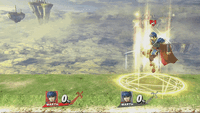
|
|---|
Taunts
- Up taunt: Points the Falchion skyward with a quick spark of light emitting at the tip. This is similar to his stance before he performed his Critical Hit animation in the Fire Emblem series and identical to his stance while performing his Lodestar technique.
- Side taunt: Swings the Falchion twice before sheathing it.
- Down taunt: Swings the Falchion around and says: みんな、見ていてくれ! ("Everyone, please watch over me!")
| Up taunt | Side taunt | Down taunt |
|---|---|---|
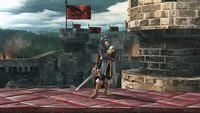
|
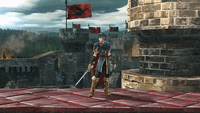
|
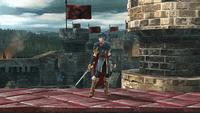
|
.
Idle poses
- Holds his hand to his chest, closes his eyes, and silently takes a breath.
- Brushes his hair out of his face.
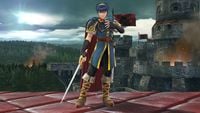 |
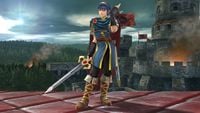
|
|---|
Crowd cheer
| English | Japanese | |
|---|---|---|
| Cheer | ||
| Description | Marth! Marth! Marth! | Mar-u-su! |
| Pitch | Group chant | Group chant |
Victory poses
- Turns with pride, spins the Falchion then poses with it pointed to the ground, and says "今回は僕の勝ちだね。", which translates to "This time it's my victory, isn't it?"
- Poses with the Falchion sheathed and his right hand over his face before dramatically moving his arm away from his head while saying "僕は負ける訳には行かないんだ。", which translates to "There's no way I can lose!" Marth keeps a stern expression before smiling once the victory pose is over on the Nintendo 3DS version, while smiling throughout the entire pose on the Wii U version.
- Sheaths the Falchion and stands facing the camera, while saying "今日も生き延びることが出来た。", which translates to "Today, I have survived."
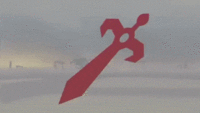 |
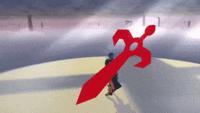 |
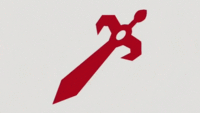
|
|---|
In competitive play
Official Custom Moveset Project
| Character | Custom sets available | ||||
|---|---|---|---|---|---|
| 3113 | 3123 | 1123 | 3133 | 1133 | |
| 3121 | 1121 | 3111 | 1131 | 3131 | |
Notable players
Active
Inactive
Trophies
- Marth
The first hero from the Fire Emblem series, Marth is the prince of Altea and descendant of the hero Anri. In Smash Bros., he's known as an exceptional swordfighter, swinging his blade with grace. Striking with the tip will maximize the damage dealt. Teach aggressive foes a lesson with his strong Counter move.
Marth, the prince of Altea, is the hero of the first ever Fire Emblem game and its remake, Fire Emblem: Shadow Dragon. In this game, his graceful sword skills are what set him apart. Strike with the tip of his blade to deal extra damage, and use his Counter skill to defend yourself, no matter which directions you're being attacked from.
: Fire Emblem: Shadow Dragon and the Blade of Light (JP)
: Fire Emblem: Mystery of the Emblem (JP)
- Marth (Alt.)
Marth's side special, Dancing Blade, is a four-stage attack. Aim and time your strikes carefully! As usual, the tip of his sword does the most damage. For his up smash, Justice Sword, he thrusts his blade into the air. You can use it to block attacks from above, and even to launch nearby enemies off the ground."
: Fire Emblem: Shadow Dragon and the Blade of Light (JP)
: Fire Emblem: Mystery of the Emblem (JP)
- Critical Hit (Marth)
Marth raises his Exalted Falchion to the sky and then rushes forward to deal an incredibly powerful blow, almost certainly KO'ing anyone and everyone who gets hit! When it's used in the air, he'll fly forward a certain distance. On the ground, however, he'll only dash to the edge of the platform he's standing on.
Marth raises his Exalted Falchion to the sky, then rushes forwards to deal an incredibly powerful blow, almost certainly KOing anyone and everyone who gets hit! When used in the air, he'll fly forwards a set distance, but on the ground, he'll only dash up to the edge of the platform he's standing on.
- MarthTrophy3DS1.png
Classic (3DS)
- MarthTrophy3DS2.png
Alt. (3DS)
In Event Matches
Solo Events
- All-Star Battle: Melee: Marth is one of the opponents fought in this event. All opponents featured had debuted in Melee.
- In the Name of the Hero-King: Marth must defeat Lucina in a stamina battle.
- The Ultimate Swordsman: Marth is one of the seven opponents Ike must defeat.
- Unwavering Chivalry: Meta Knight must defeat Marth without KOing Peach or Zelda.
Co-op Events
- A Royal Errand: Marth and Robin must work together to collect 500G from Wario and Bowser in a coin battle before the stage reaches the Bazaar.
- The Ultimate Battle: Two players must select their characters and defeat the entire roster (prior to DLC).
Alternate costumes

| |||||||

|

|

|

|

|

|

|

|
Gallery
Marth's amiibo.
Battling with Link.
Using down smash on Wii Fit Trainer.
Using Dolphin Slash on Mega Man.
Posing with Peach.
Close-up image of Marth and Luigi's faces.
Marth and Samus near a Steel Diver.
In battle with Zelda.
Landing with Ike.
Trivia
- Despite now only grunting instead of talking when doing his Counter, the voice clips of him speaking are still in his Sound Test. Interestingly, Marth can be heard talking while countering in Roy's reveal trailer.
- Dashing Assault makes a "woosh" sound when used, but in Corrin's reveal trailer it makes the "shing" sound when executed, likewise when Marth performs his standard Shield Breaker.
- Marth, Roy and Cloud are the only characters to speak Japanese in every regional version of Super Smash Bros. 4.
- Marth's sword and its sheath are not present in his artwork for the cover of Super Smash Bros. for 3DS.
References
| Fighters in Super Smash Bros. 4 | |
|---|---|
| Veterans | Bowser · Captain Falcon · Charizard · Diddy Kong · Donkey Kong · Dr. Mario · Falco · Fox · Ganondorf · Ike · Jigglypuff · King Dedede · Kirby · Link · Lucario · Lucas · Luigi · Mario · Marth · Meta Knight · Mewtwo · Mr. Game & Watch · Ness · Olimar · Peach · Pikachu · Pit · R.O.B. · Roy · Samus · Sheik · Sonic · Toon Link · Wario · Yoshi · Zelda · Zero Suit Samus |
| Newcomers | Bayonetta · Bowser Jr. · Cloud · Corrin · Dark Pit · Duck Hunt · Greninja · Little Mac · Lucina · Mega Man · Mii Fighter (Mii Brawler · Mii Gunner · Mii Swordfighter) · Pac-Man · Palutena · Robin · Rosalina & Luma · Ryu · Shulk · Villager · Wii Fit Trainer |
|
| |
|---|---|
| Fighters | Marth (SSBM · SSBB · SSB4 · SSBU) · Roy (SSBM · SSB4 · SSBU) · Ike (SSBB · SSB4 · SSBU) · Lucina (SSB4 · SSBU) · Robin (SSB4 · SSBU) · Corrin (SSB4 · SSBU) · Chrom (SSBU) · Byleth (SSBU) |
| Assist Trophies | Lyn · Black Knight · Tiki |
| Stages | Castle Siege · Arena Ferox · Coliseum · Garreg Mach Monastery |
| Item | Killing Edge |
| Other | Sothis |
| Trophies, Stickers and Spirits | Trophies (SSBM · SSBB · SSB4) · Stickers · Spirits |
| Music | Brawl · SSB4 · Ultimate |
| Masterpieces | Fire Emblem: Shadow Dragon and the Blade of Light · Fire Emblem: Mystery of the Emblem |
